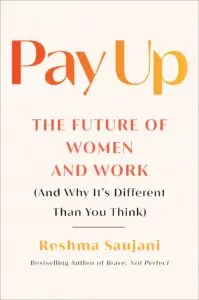“Before the pandemic, I used to go into a panic whenever I woke up to an email from my kids’ school saying they were closed for a snow day,” said Marianna, a mother of three kids under the age of nine. “I’d get such a pit in my stomach knowing that my entire workday would be lost and that my boss who has no kids and likes to call mine ‘rug rats’ would definitely not understand. I laugh about that now because 2020 was like the longest snow day from hell.” If the pandemic showed us anything, it’s that the availability of childcare dictates women’s ability to work and, in the longer term, to stay in the workforce at all. When care centers and schools closed, forcing millions of women to leave the workforce because they relied on those resources or employed caregivers who in turn relied on these resources for their own children it became crystal clear that access to childcare is a key component to the future of work. Bottom line: Without affordable, reliable, quality childcare, we cannot work. Our livelihood literally depends on this.

In Pay Up, I’ve identified nine key strategies to effect the critical changes needed to specifically support women. These strategies were developed in response to a survey of a thousand American mothers conducted jointly by the Marshall Plan for Moms and advisory and advocacy communications firm APCO Impact, and supported with research from hundreds of studies, articles, and guides, as well as insights from leading labor experts, diversity and inclusion practitioners, and visionaries shaping the future of the workplace.
Each of these strategies outlines what companies can do to change the reality for the women they employ and, at the same time, improve their bottom line. The work to repair and rebuild our workplaces for this new future requires serious commitment, but the companies that recognize their fundamental responsibility to take action will also be the ones who ultimately survive the new normal that emerges.
It will also give us, as women in the workforce, strongly substantiated facts and arguments as to why these changes are so vital and insights into how we can push this agenda forward.
One of the strategies for supporting women that I’m most passionate about is childcare. Every working parent needs a childcare arrangement that fits their unique family situation and working schedule, so options are key. Here is the spectrum of solutions some companies are already offering to enable families to tailor solutions that work for them:
- Offer employees access to resources that help find care givers and babysitters in your area. Best Buy, Starbucks, and CarGurus give their employees access to Care.com, a resource to find babysitters and other caregivers. Fidelity Investments provides a concierge for parents to help them find availability in local daycare centers.
- Provide free or subsidized on-site care. Mercedes Benz, Georgia Pacific, Aflac, Cerner, Goldman Sachs, Johnson & Johnson, and many other large corporations have recognized this pressing need and invested in on-site facilities.
- Provide free or subsidized care at a childcare center or in-home. Facebook provides an annual childcare subsidy of $3,000 and Bank of America reimburses eligible employees up to $275 per month for childcare. Citibank provides its employees with subsidies for external childcare and eldercare.
- Provide free or subsidized backup care. Amazon, Apple, and General Motors have partnered with Bright Horizons Family Solutions to provide backup care for their employees. Facebook subsidizes ten days per year of backup care and Bank of America provides fifty.
- Negotiate discounts on behalf of your employees with local childcare centers. Companies already offer employees museum discounts and gym memberships—this should be a no-brainer.
- Offer flexible spending accounts so parents can pay for childcare with pre-tax dollars. As of 2018, 67% of companies offered dependent care FSAs.
America has faced a childcare crisis for years. The supply is way below the demand, and many lower-income families either live in areas outside of major cities that are childcare deserts or barely scrape together tuition. According to the Institute of Child, Youth and Family Policy at Brandeis University, in 2018, childcare was unaffordable for 63% of full-time working parents. But parents who earn a decent in come are not guaranteed to find a viable childcare solution, either. Though the Department of Health and Human Services recommends that families spend no more than 7% of their income on childcare, couples earning the national median income of $87,757 spend an estimated 10.6% on childcare (for one child, costs increase exponentially for additional children). Single parents of which this country has the highest percentage in the world-may spend up to 37%.
In the wake of the pandemic, agencies who place in-home nannies and babysitters are reporting a nationwide shortage of private caregivers resulting in skyrocketing premiums for these roles that many families simply cannot afford to pay. A publicist I know who is married to a college professor lamented, “I earn a good living, but honestly, at this point I am working just to pay for the babysitter. My wife and I sit around every night and wonder if it’s really worth it… if one of us should just stay home with our kids instead and make some cuts.”
That is a depressing choice. At the same time, many families in America do not have the luxury of even considering this option, as the financial stability of their family unit depends on the dual income of both parents and there are no viable cuts they can make. That reality is even more stark for single parents who are the sole support system for the family. In those instances, being unable to pay for childcare so both parents can work goes from being a troubling burden to a serious crisis.
Less than half of U.S. employers gave childcare assistance during the pandemic, though mainly through remote working and flexible scheduling options. Only 1% provided direct support in the form of backup childcare or on-site facilities. As advocacy group Time’s Up reported, while the former was helpful (somewhat) during the long months of lockdown, if companies want to bring women back into the workforce, this direct support isn’t just a perk that’s “nice to have.” It’s a must.
Excerpted from Pay Up : The Future of Women and Work (And Why It’s Different Than You Think) published by One Signal/Atria Books, a division of Simon & Schuster, Inc. Copyright © 2022 by Reshma Saujani.
Reshma Saujani is the founder of Girls Who Code and the Marshall Plan for Moms, as well as the author of Pay Up: The Future of Women and Work (And Why It’s Different Than You Think) and the bestseller, Brave, Not Perfect. She has spent more than a decade advocating for women’s and girls’ economic empowerment, working to close the gender gap in the tech sector, and, most recently, championing policies to support mothers impacted by the pandemic.
Recognize your brand’s excellence by applying to this year’s Brands That Matter Awards before the early-rate deadline, May 3.
